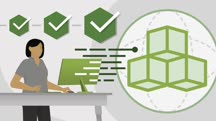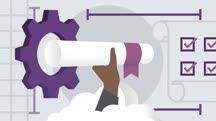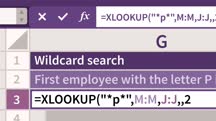Course catalog
Categories
Showing 481-500 of 1,450 items.
Exam Tips: AWS Certified Developer – Associate (233305)
Get prepared for the AWS Certified Developer – Associate Exam. This course covers exam objectives, the goals of the exam itself, and the AWS whitepapers that are recommended reading for the exam. Instructor Carlos Rivas focuses first on deployment, including exam objectives, key points in AWS deployment options, and deployment-related recommended reading. Next, Carlos covers security concepts, with a focus on authenticated calls, encryption, and security whitepapers. Carlos goes into development with AWS services, with a useful demonstration of question-answering strategies. He covers refactoring, then discusses monitoring and troubleshooting. Plus, he walks you through a practice exam, what to expect on exam day, and what to do after you pass your exam.
Exam Tips: AWS Certified SysOps Administrator (2020) (230245)
Earning the AWS Certified SysOps Administrator – Associate certification validates your ability to operate within the AWS ecosystem. This course was designed to help IT professionals prepare for this introductory-level exam by highlighting the key topics covered on the exam, and providing tips and tricks that can help you approach the exam with confidence. Instructor Sharif Nijim outlines the benefits of certification, and identifies resources that cover the exam concepts in depth. He also explains how to register for the exam, and discusses recertification options.
Exam Tips: AWS Certified SysOps Administrator (SOA-C02) (219331)
Are you getting ready to take the latest AWS Certified SysOps Administrator (Associate) exam—SOA-C02? This course serves as an exam prep best practices guide. Not intended as a deep dive into teaching the skills to be tested on, this course instead discusses the importance of certification, where this exam falls within AWS certification hierarchy, and how to identify resources that you can use to feel confident about taking the exam. Instructor Sharif Nijim explains the differences between the Associate and Professional levels of AWS certification and covers some good reasons to get certified. He offers useful tips on preparing for the exam, including the objectives, domains, and concepts that the exam covers. Plus, Sharif discusses final exam prep, taking the exam, and exploring options for recertification.
Exam Tips: Certified Associate in Project Management (CAPM)® (121190)
Learn key tips and insights to help you pass the Certified Associate in Project Management (CAPM)® exam on your first attempt. This course has been updated for the latest CAPM® exam objectives, and guides you through the examination process from beginning to end. Oliver Yarbrough shares straightforward, step-by-step methods for successfully taking and passing this exam. He reviews best practices and terminology, provides tips for managing your time most effectively, and shares his methodology for approaching the test questions.
Exam Tips: Microsoft Azure Architect Technologies (AZ-303) (221490)
Earning the Microsoft Azure Solutions Architect Expert certification shows potential employers that you can design and implement high-quality solutions that run on Azure. To earn this certification, you need to pass two exams, including the Microsoft Azure Architect Technologies (AZ-303) exam. In this course, get insights into the structure of exam AZ-303, the prerequisites, and each of the exam domains. Instructor Scott Duffy provides an overview of each of the skills tested on the exam, including how to implement and monitor an Azure infrastructure, implement management and security solutions, and implement solutions for apps. After wrapping up this course, you'll have an understanding of what you need to know to walk into the test center feeling confident.
Exam Tips: Microsoft Azure Data Fundamentals (DP-900) (220827)
Data is everywhere, and companies need it to better understand their customers and competitors and to make sound business decisions. Azure is among the best options on the market. In this course, instructor Emilio Melo covers the most important topics on the DP-900 exam, the first certification of Microsoft’s data path. Emilio explains the DP-900 certification and exam, then goes into core data concepts, such as data processing and data analytics. He goes into ways to work with relational data in Azure, including hosting options and relational database offerings in Azure. Azure also has ways to handle non-relational data, and Emilio discusses several options. He goes over analytics workloads, then concludes with insights on data warehousing in Azure and Power BI.
Excel 2021 Essential Training (Office 2021/LTSC) (215336)
Excel, the popular spreadsheet program from Microsoft, is an essential tool for many professional roles. In this course, Jess Stratton shows you the ins and outs of the 2021 release. Jess begins with how to navigate Excel and how to create, open, and save a file. Next, she shows you how to enter, format, autofill, and edit text, as well as how to copy and delete cell data, merge cells, and more. Jess explains how to work with sheets, then dives into the myriad adjustments and customizations you can apply to rows and columns. Formulas are at the heart of Excel’s ability to perform text or number calculations, so Jess concludes by walking you through formulas and functions, including AutoSum and the very useful XLOOKUP.
Excel for Mac Essential Training (Office 365/Microsoft 365) (233713)
Excel for Mac is a powerful tool, but it can be intimidating for new users who either don't know where to start or don't know how to proceed beyond the most basic tasks. In this course, learn how to master the essential tasks in the Mac version of Excel for Office 365. Excel expert Curt Frye shows how to manage workbooks, work with cells and cell data, and sort, filter, and manage worksheets. Plus, learn how to summarize data using core functions and formulas; format worksheet elements; create bar, column, and line charts; create and filter PivotTables; and share your spreadsheets with others.
Excel for Mac: Advanced Formulas and Functions (365/2019) (225349)
Looking to master all the formulas and functions available in Excel for Mac? In this comprehensive course, Dennis Taylor presents numerous Excel formulas and functions and shows how to use them efficiently. Dennis begins with tips and keyboard shortcuts to accelerate the way you work with formulas within one or multiple worksheets. He then covers how to perform logical tests with the IF, AND, OR, and NOT functions, search and retrieve data with lookup functions (VLOOKUP, XLOOKUP, MATCH, and INDEX), analyze data with statistical functions, use text functions to clean up worksheets, work with array formulas and functions, and master date and time calculations. If you’re looking to up your formulas and functions skills in Excel, join Dennis as he uses practical examples that transition effortlessly to real-world scenarios.
Excel for the Web Tips and Tricks (Office 365/Microsoft 365) (209556)
Excel for the web offers many powerful features, but because its interface differs from the interface of the desktop tool, most users only use its basic spreadsheet functionality. In this course, instructor Joshua Rischin shows you how to get more out of Excel for the web. Joshua explains some basics of data, including how to cleanse data and use Flash Fill to add data quickly. He gives several useful tips for using custom formatting, hyperlinks, and conditional formatting in Excel for the web. Joshua goes over how to customize your workbooks, as well as create Pivot Tables and Pivot Charts. He covers ways to collaborate, while still protecting your work, and discusses how to use Excel Desktop to get even more from your Excel for the web experience. He steps you through some advanced features, like Excel Ideas and scripts, then concludes with advice on how to apply what you’ve learned from the course.
Excel Modeling Tips and Tricks (216101)
Excel is the most widely used data analysis software on the market, but many people in business are not using it to its full potential. Excel can be a great tool for building financial and operational models, allowing users to understand what may happen in the future and how the business can position itself. In this course, learn how to build effective and useful financial models in Excel to forecast sales and costs, profits, operational KPIs, business assets and liabilities, and much more. Instructor Michael McDonald covers rules and best practices for financial modeling and then shows how to set up single-sheet and multi-sheet financial models and add inputs and assumptions, external data, projections, and more. Plus, learn how to determine the accuracy and strength of your models and keep them up to date as the data evolves. By the end of this course, you will have the tools and tricks you need to become a master of Excel modeling for businesses ranging from restaurants and manufacturing firms to banks and software companies.
Excel Quick Tips (217444)
The most common questions about using Excel now have timely video answers. This set of quick tips provides helpful, condensed steps you can readily apply to keep on task—whether you're running calculations, setting up a new workbook, fixing a sheet you received, or getting tables ready for presentation. Each video is about one minute long, so you can jump in and get some helpful insights in no time.
Excel Statistics Essential Training (279596)
Excel Statistics Essential Training: 1
Excel Supply Chain Analysis: Managing Simulations Using VBA (219637)
Did you know you can record and run Solver macros, generate random inputs, run multiple simulations, and more, in Excel? Moreover, you can do all this without buying expensive specialty software. In this course, instructor Curt Frye shows how to enhance your supply chain analysis using the Solver add-in in combination with VBA. Working from an example transportation problem, Curt steps through creating a reference to the Solver VBA library, recording and running a Solver macro, generating random inputs, and defining a loop structure to run multiple simulations. Then he moves on to enabling detailed analysis by writing model output, creating a results dashboard to analyze your model output, exploring alternative scenarios with a Solver model, and more.
Excel: Advanced Formulas and Functions (193950)
Follow along with Excel expert Dennis Taylor as he demystifies the hundreds of formulas and functions available in Excel. Dennis starts with a few critical formula shortcuts that will speed up your work, then covers a variety of functions, such as VLOOKUP, MATCH, and INDEX, statistical functions, text functions, and date and time, math, text, and information functions. Dennis provides practical examples to help viewers easily transition to using Excel's most powerful formulas and functions in real-world scenarios. Note that this course is recorded in Excel for Office 365 but anyone using a recent version—including 2019, 2016, and 2013—will be able to follow along.
Excel: Conditional Formatting for Beginners (217818)
Conditional formatting sounds more complicated than it is. This powerful tool in Microsoft Excel allows you to highlight data based on cell contents, making it easy to spot trends and patterns and emphasize key results. Though this process can be quick and easy, many Excel users don't know how to use conditional formatting to its fullest potential. In this short course, Excel trainer Dennis Taylor walks you through how to apply and customize conditional formatting to quickly pinpoint variances in your data. Learn how to use all the rules and options, such as data bars and icon sets, and apply conditional formatting across many rows of data.
Excel: Introduction to VBA (227678)
Excel macros allow you to automate routine tasks. Although working with macros involves the Visual Basic for Applications (VBA) programming language, you don’t need to be a programmer to use it. In this course, Excel guru and Microsoft content developer Chris "Smitty" Smith provides a quick introduction to macros and VBA. He walks through the steps of recording a basic macro, then demonstrates how to edit macros, including testing and adjusting, and making recorded macros dynamic. Learn how to do more with Excel using macros.
Excel: Power Query for Beginners (210236)
If even a small part of your job entails using Microsoft Excel, there’s a good chance that at some point you’ve received a spreadsheet where the data is unorganized, disconnected, or generally not in great shape. And despite common practice, a long, heavy sigh is not officially part of any recommended Excel workflow. Rather than pull your hair out at the mess of data you see before you, you can use Power Query in Excel to help you import and clean data into something easier to work with. In this course, Excel expert Dave Ludwig takes you through the robust features set of Power Query. Dave shows you how to use Power Query to connect to your data source, filter data, and create conditional columns of data. He also shows off the significant cleansing capabilities of Power Query. Once your data is cleaned up, you can more easily create formulas, PivotTables, charts, and generally get on with your business.
Excel: Sales Forecasting (229871)
Creating accurate and reliable sales forecasts is essential for any sales leader. Professor Michael McDonald shows how to use Excel to forecast sales more effectively, beginning with a quick primer on sales forecasting, then explaining the business intelligence used in forecasting and the basics of regression analysis. Next, Michael shows how to use Excel to gather the necessary data for your forecast, how to cleanse data so that it will lead to more accurate forecasts, and how to interpret and explain the results of a regression forecast. The course concludes with a sample project, forecasting sales for a fictional restaurant. In this sample project, you’ll construct a data set, compute a simple set of forecast metrics, and construct an in-depth sales forecast. Finally, Michael explains the limitations of sales forecasting and how you can mitigate risk.
Executive Influence (211324)
You probably already know many ways to exert influence. Methods like reason, authority, and scarcity are often effective ways to get people to do what you want. But the best leaders go beyond regular influence, in who, how, when, and why they influence, and how they extend their influence. In this course, John Ullmen details the concept of executive influence. While regular influence centers around using tactics to get tasks done, executive influence adds to that, energizing people to create possibilities for the next task and beyond. As John explains, the more chaotic and dynamic your leadership challenges become, the more you need executive influence to succeed. John shares his executive influence roadmap, using real-world examples from exceptional leaders he’s coached, and details tools you can use to generate better outcomes and multiply your positive influence when regular influence techniques are not enough.



















